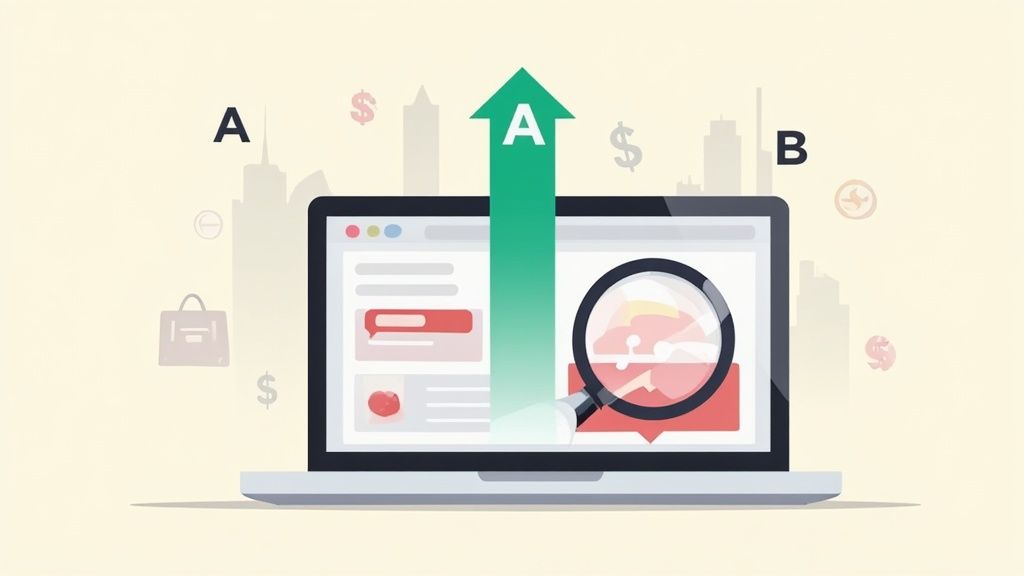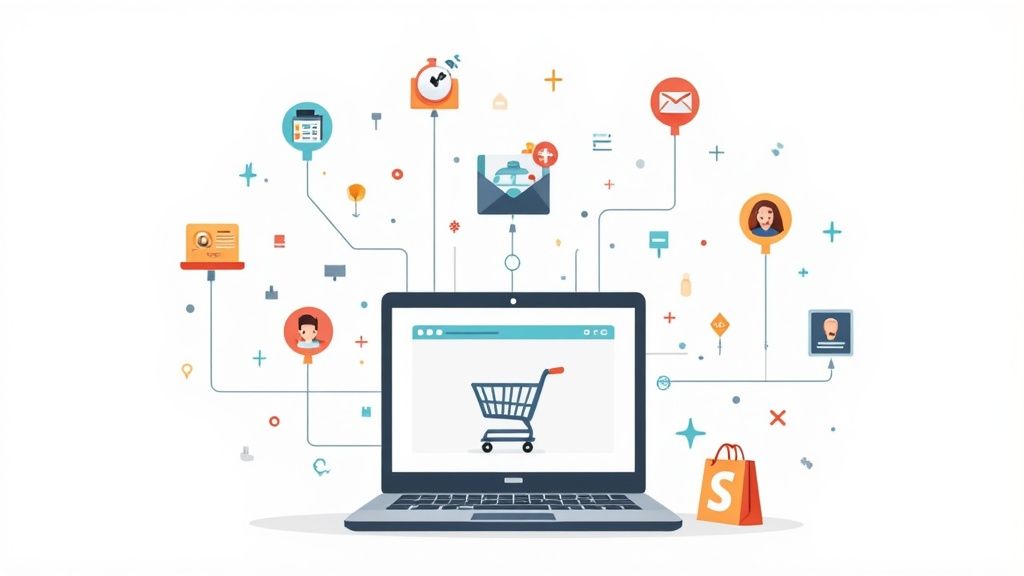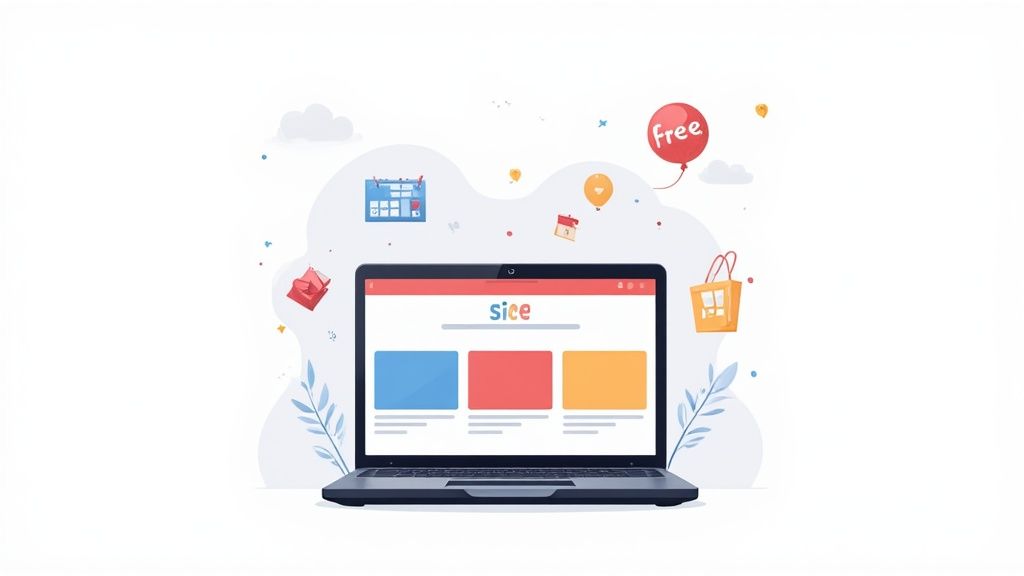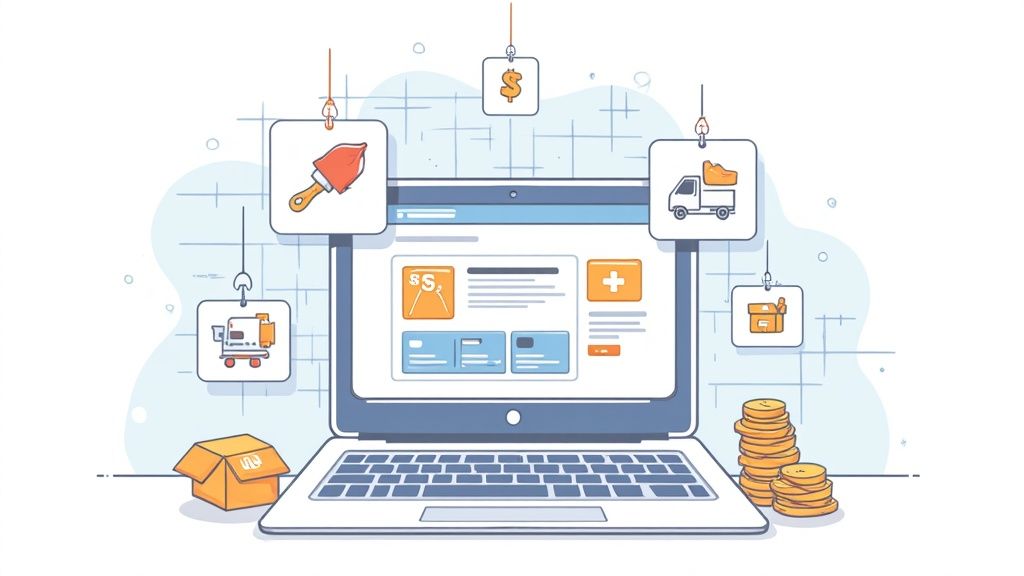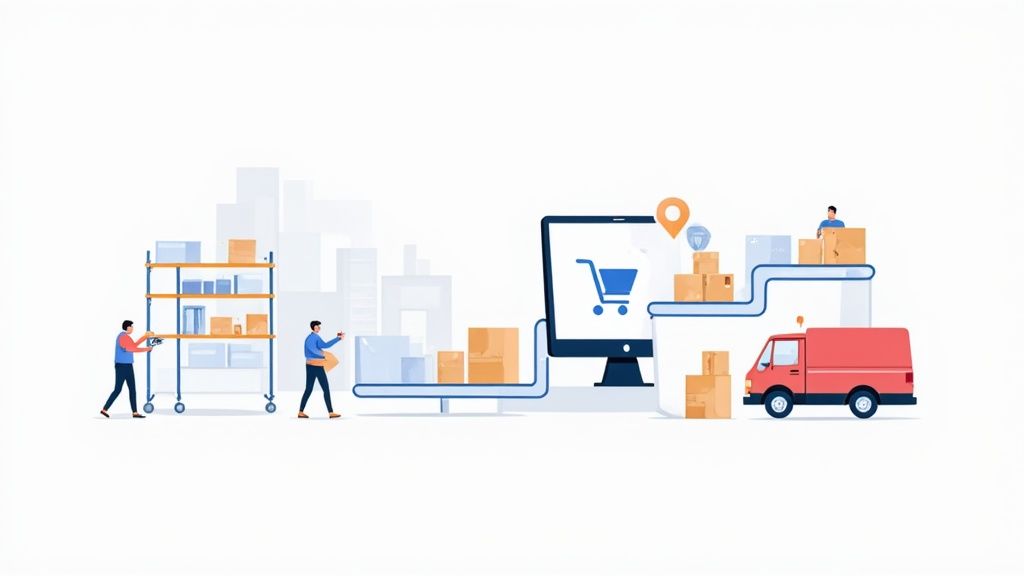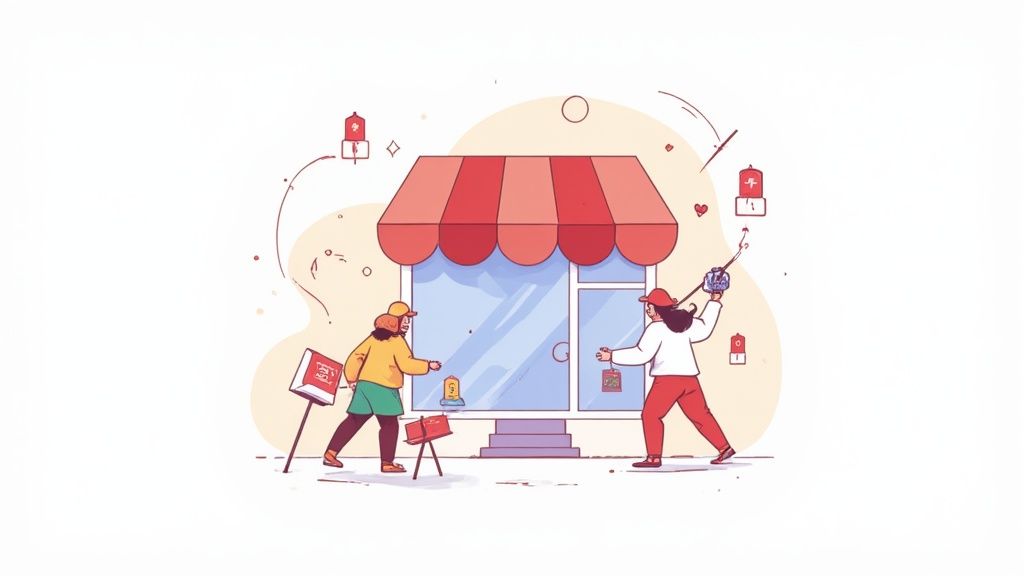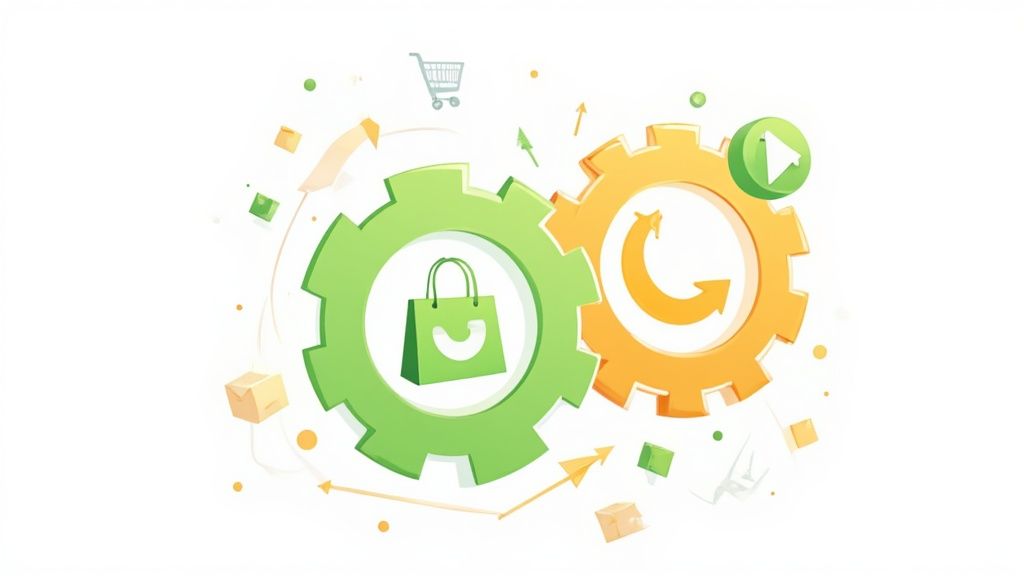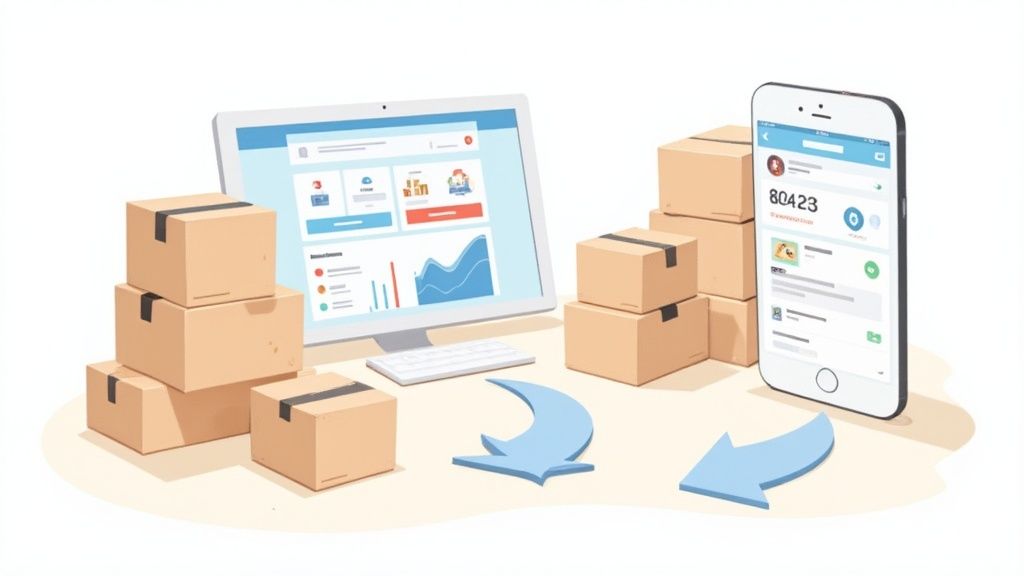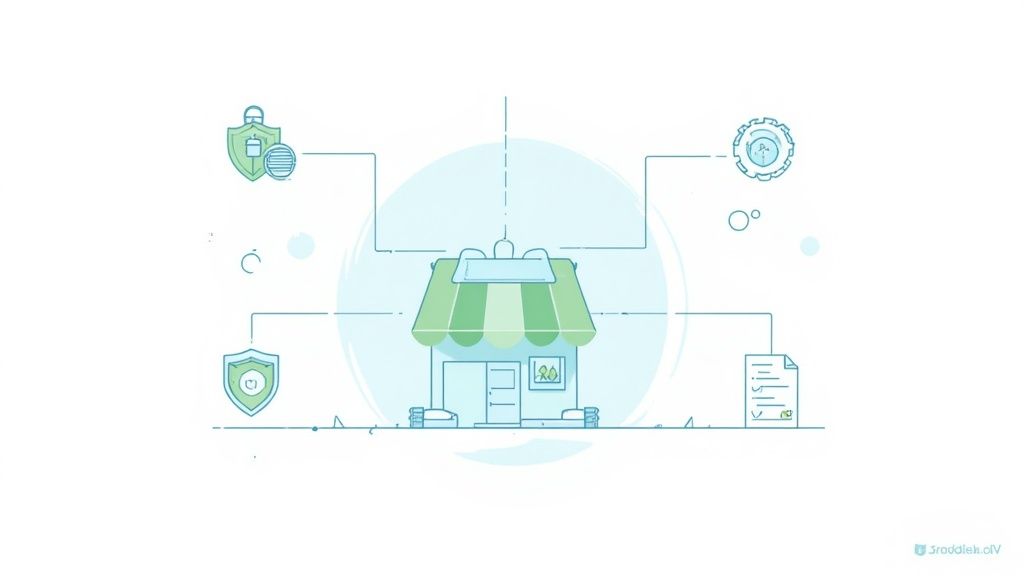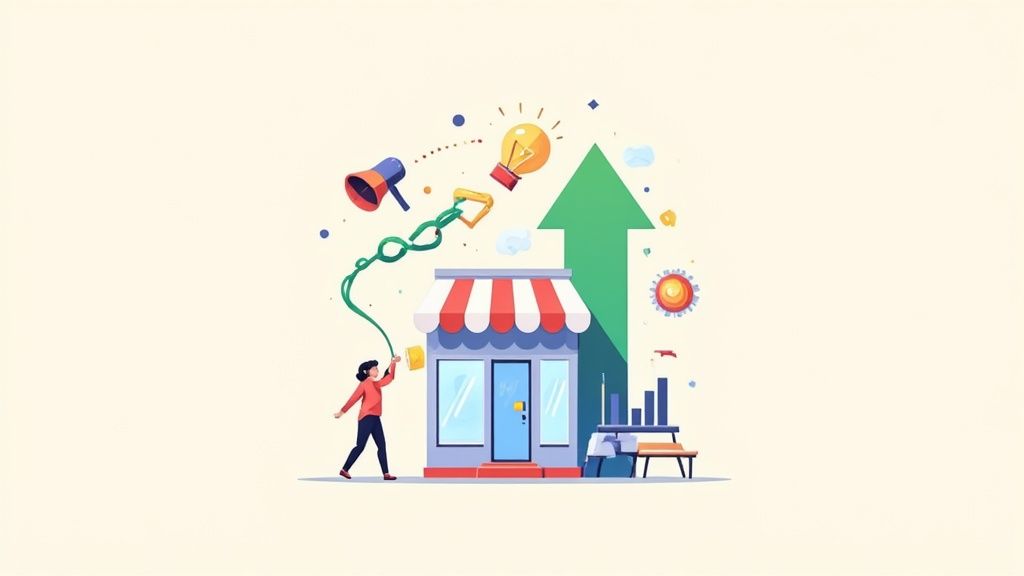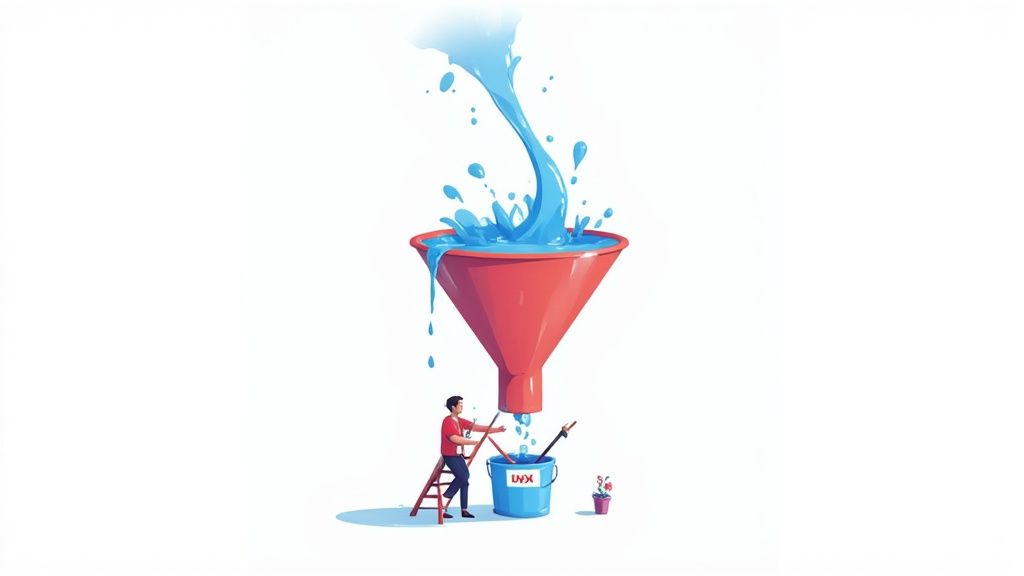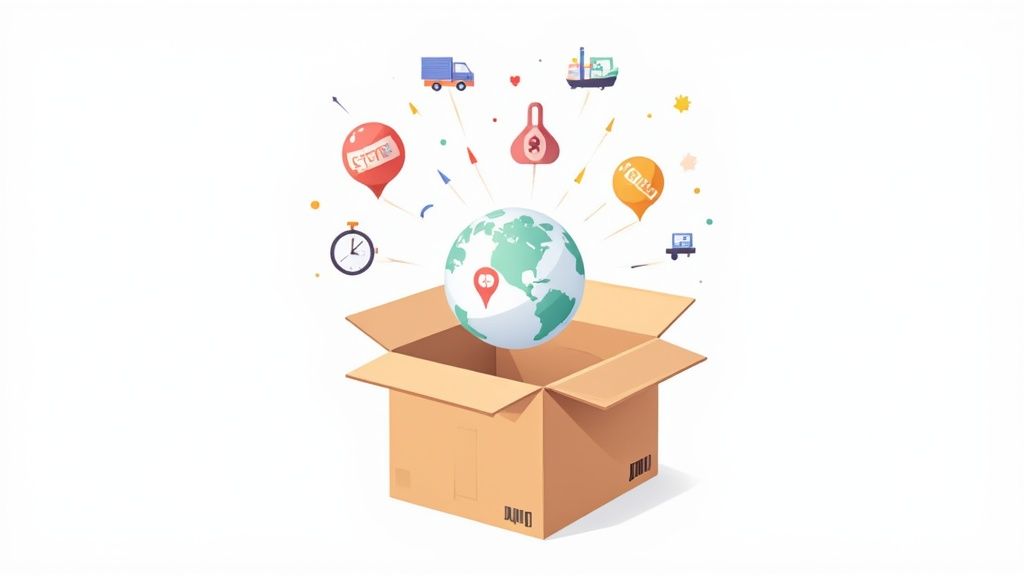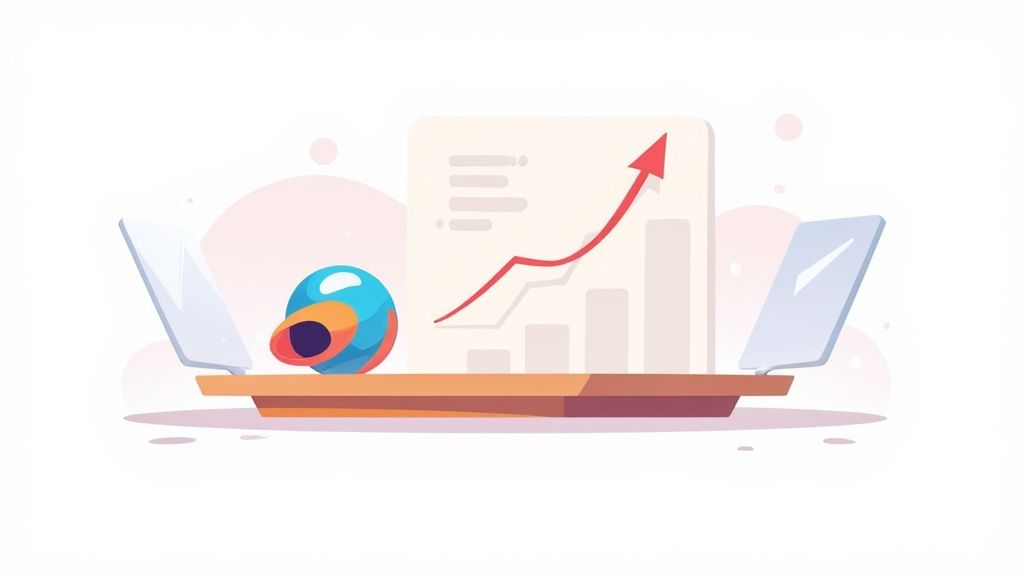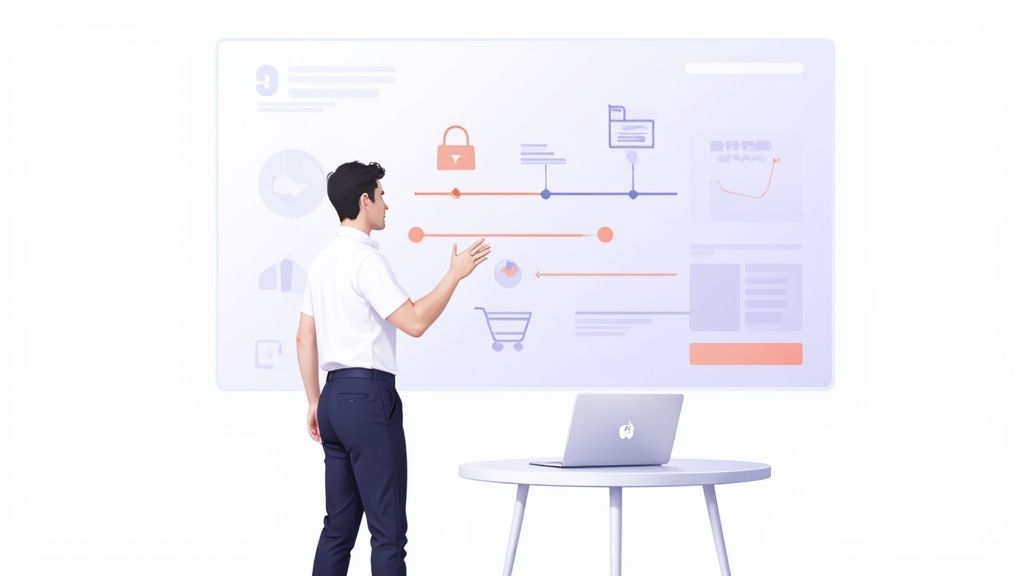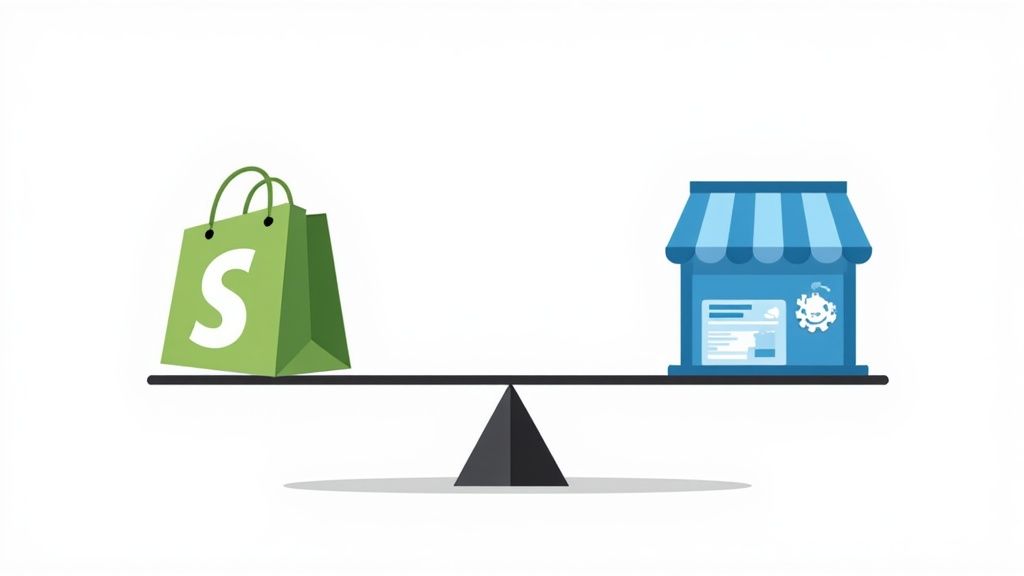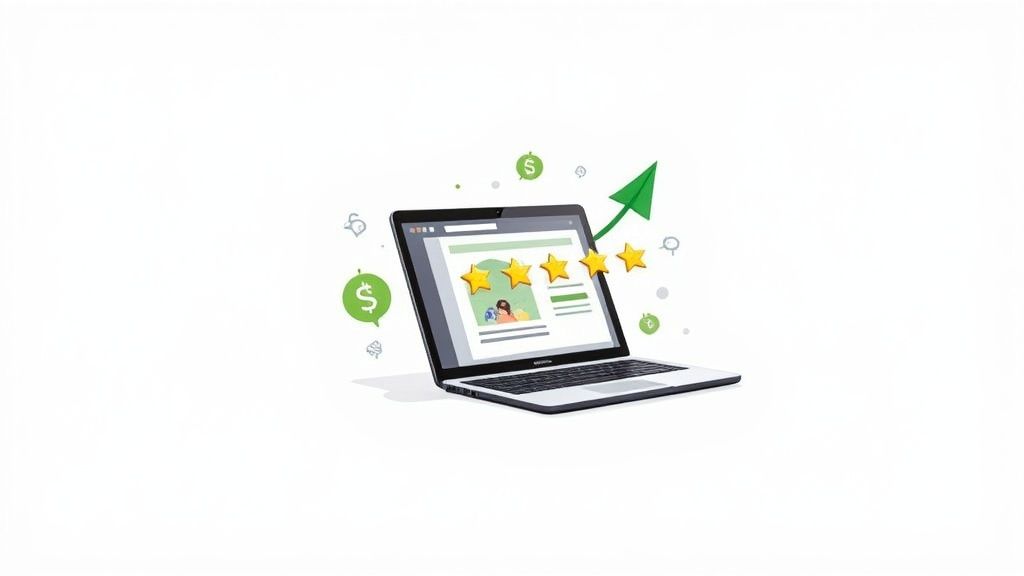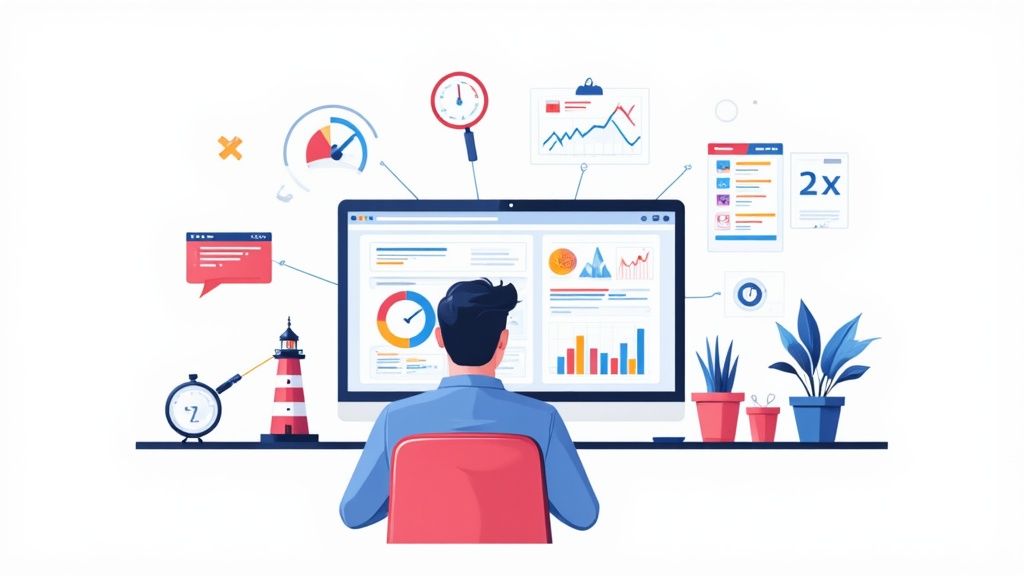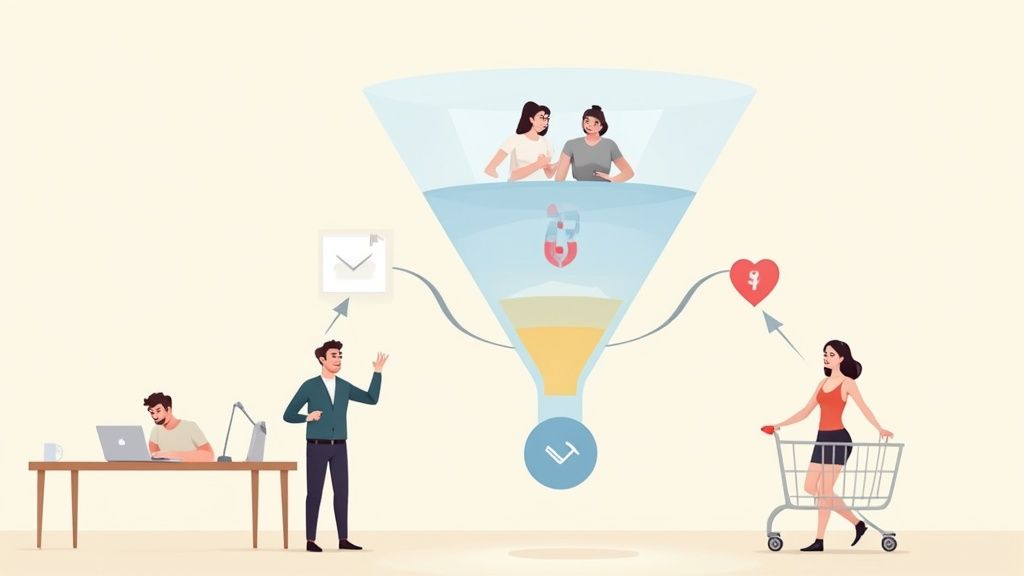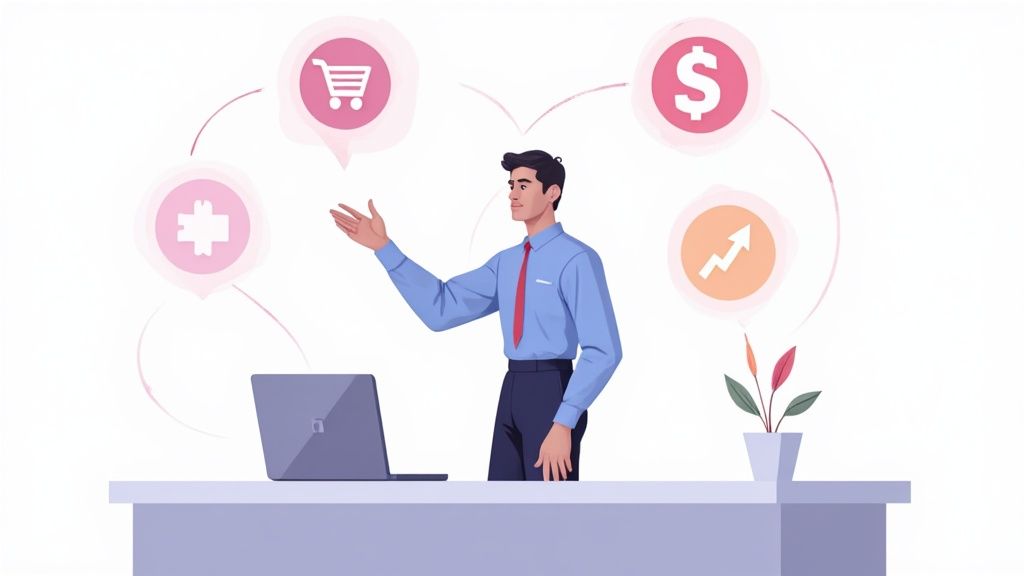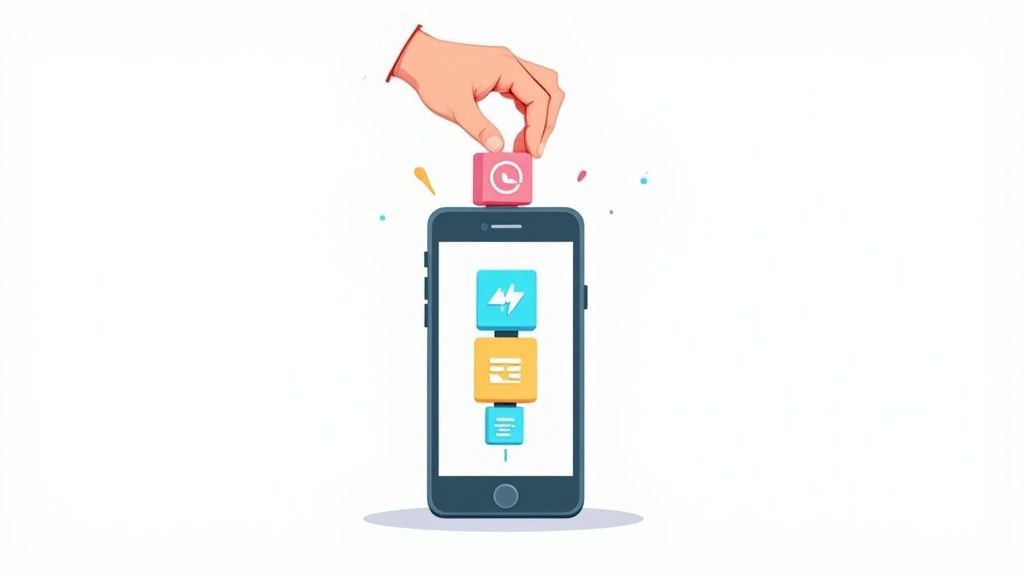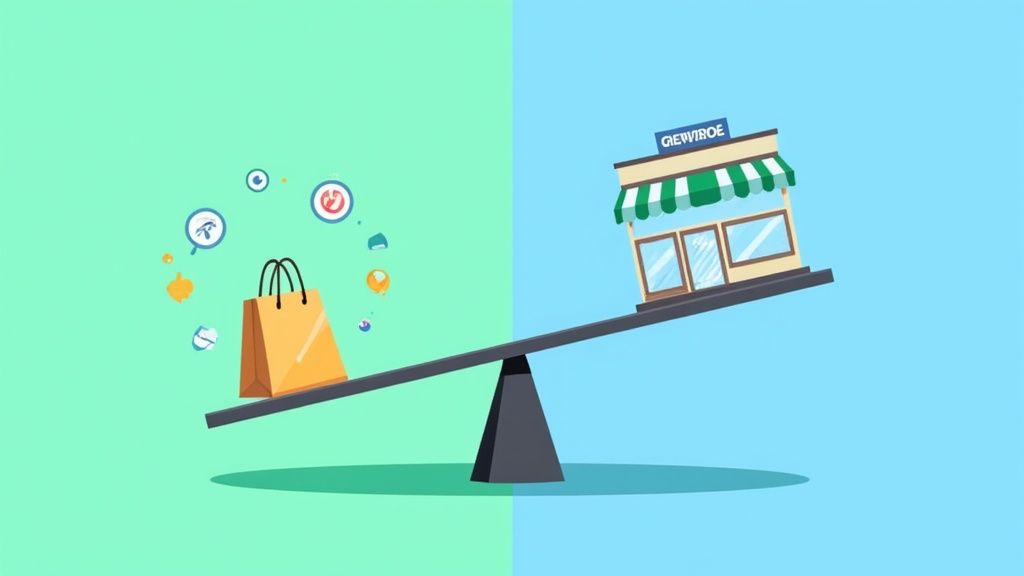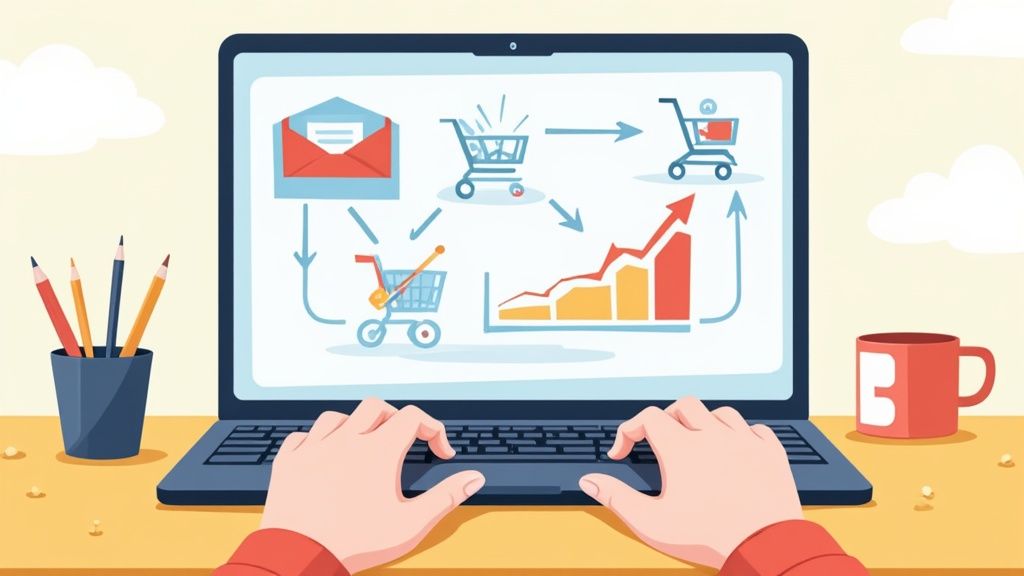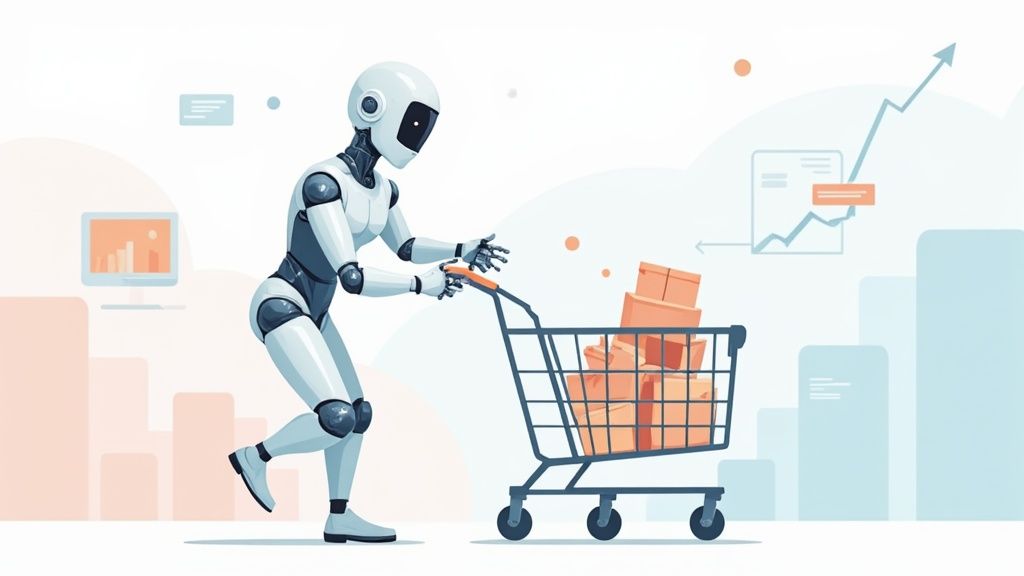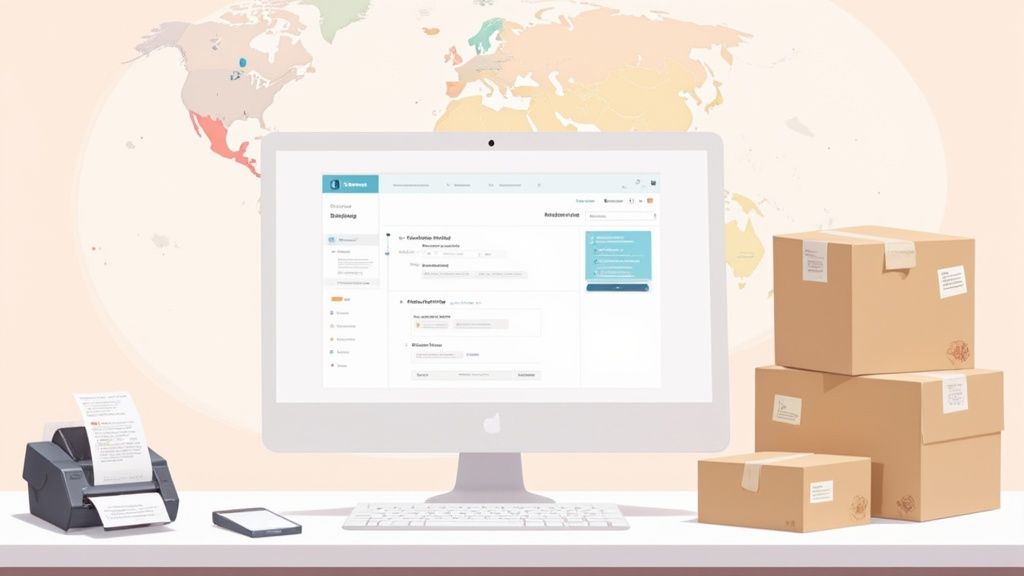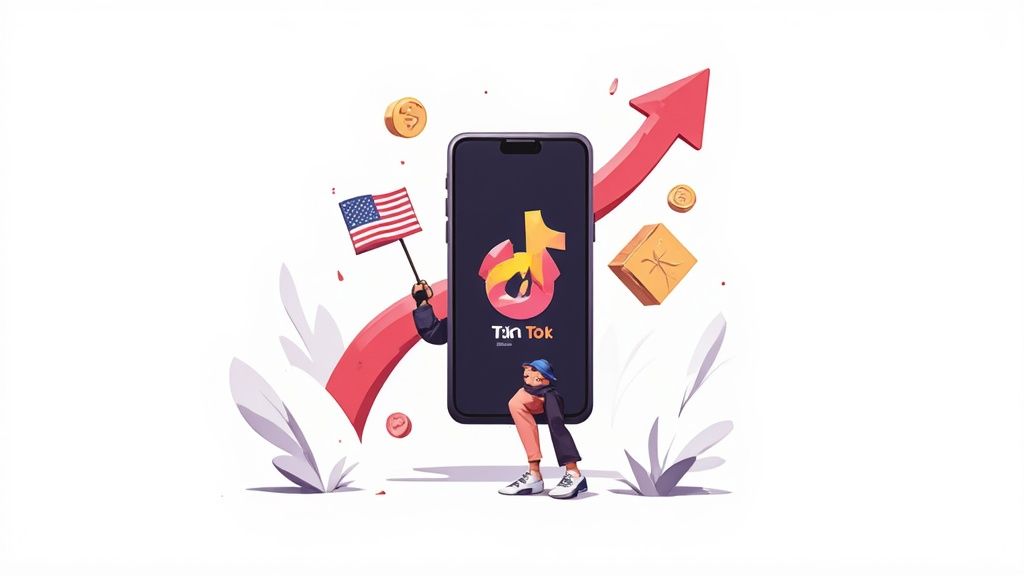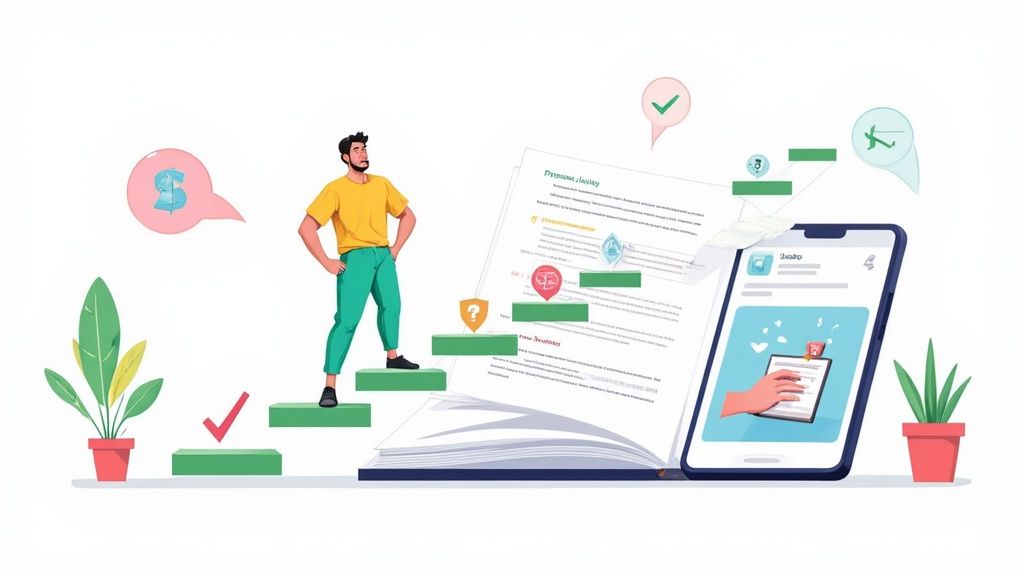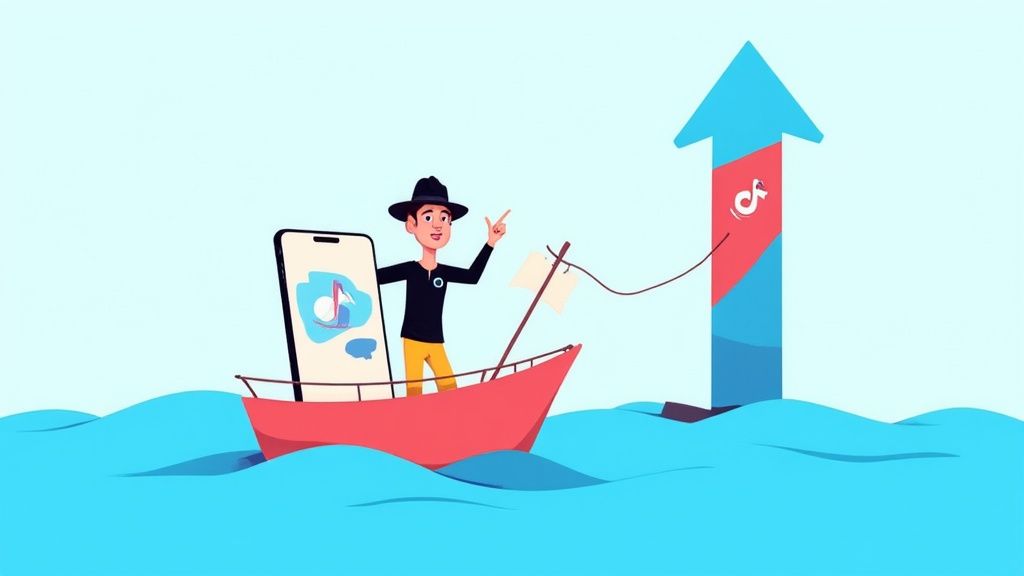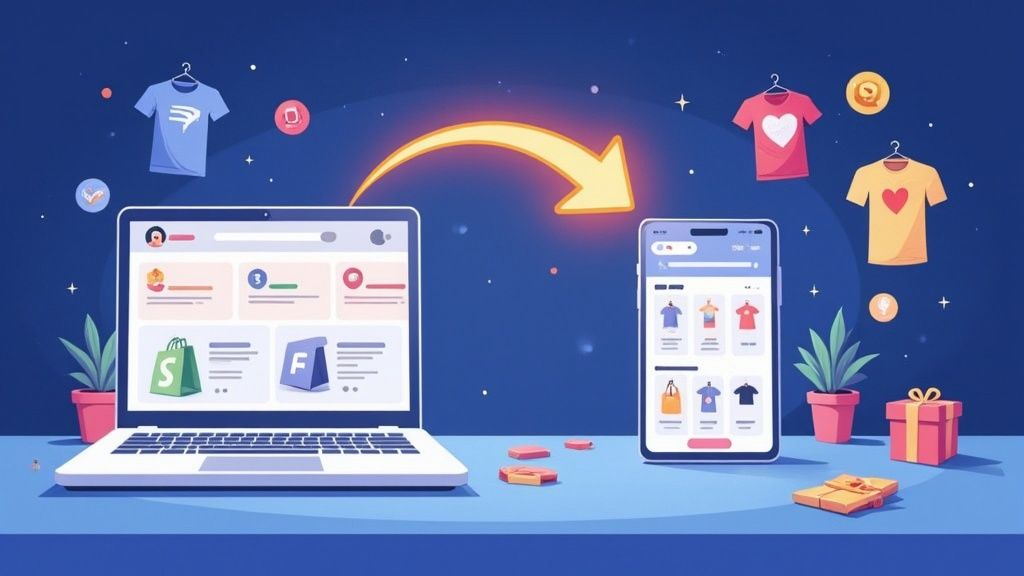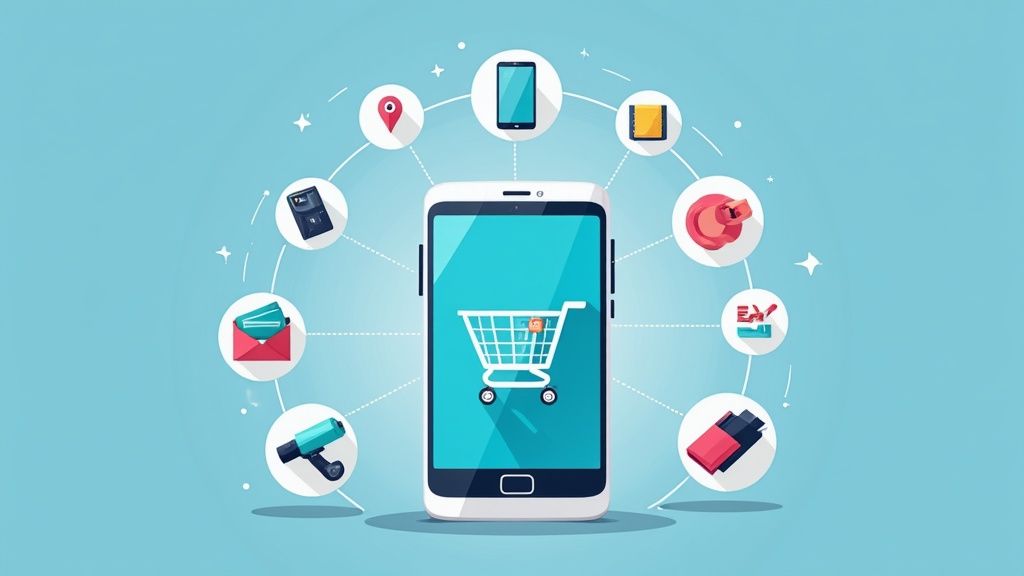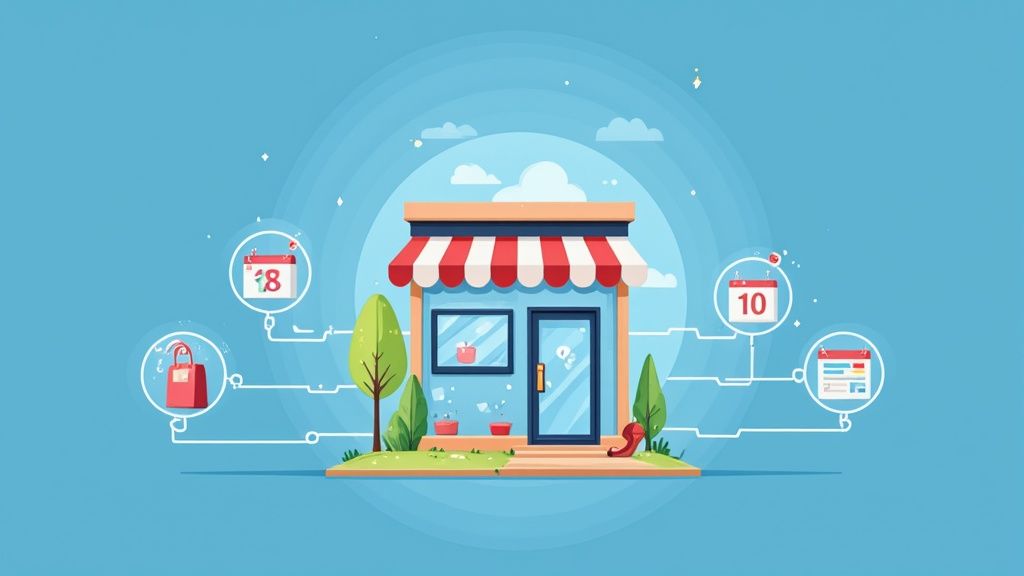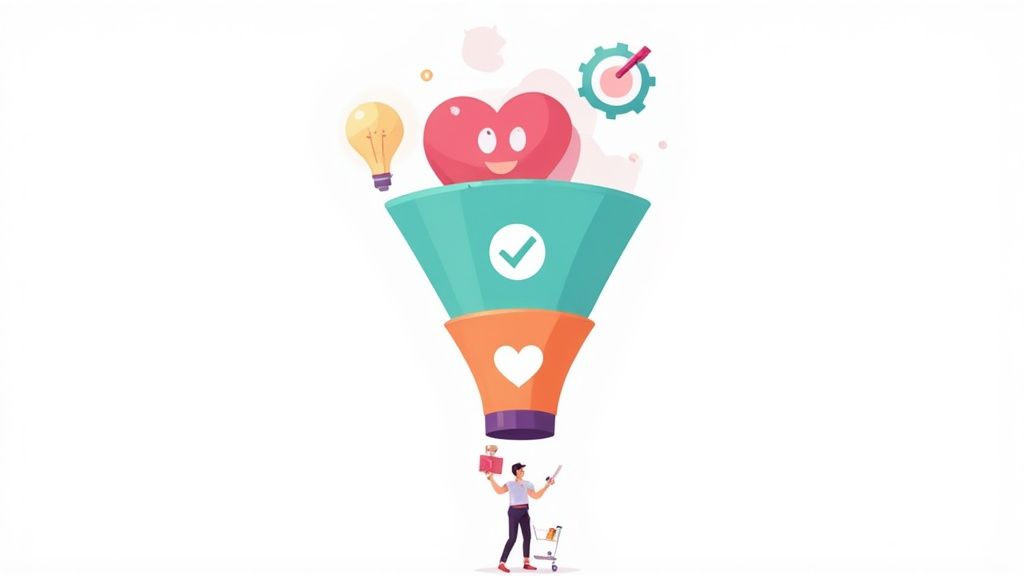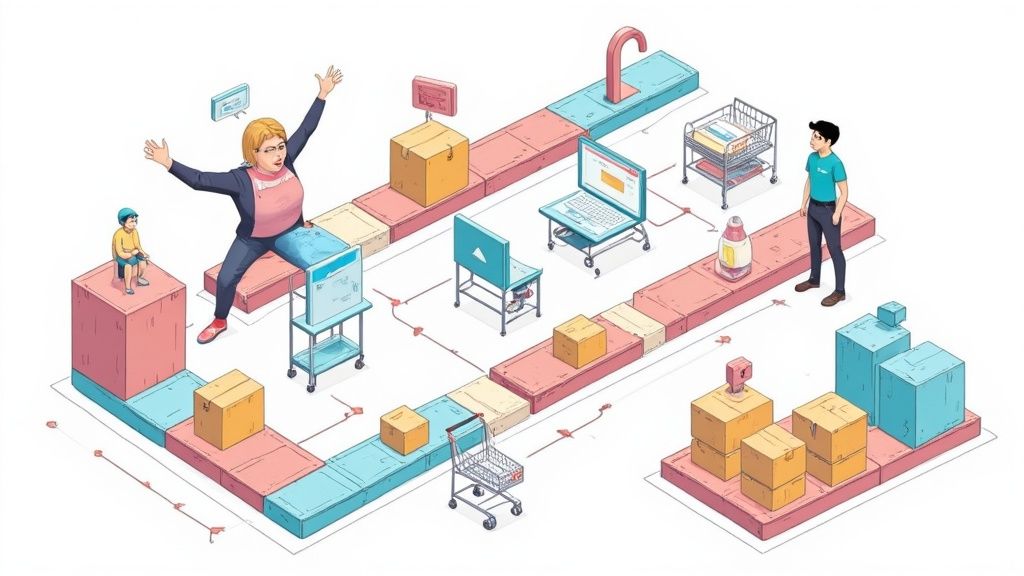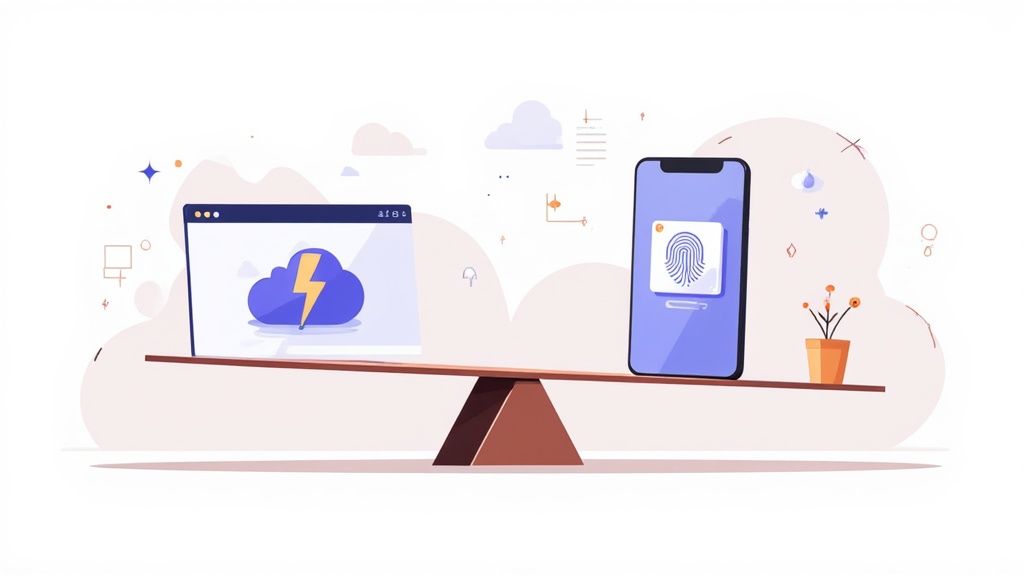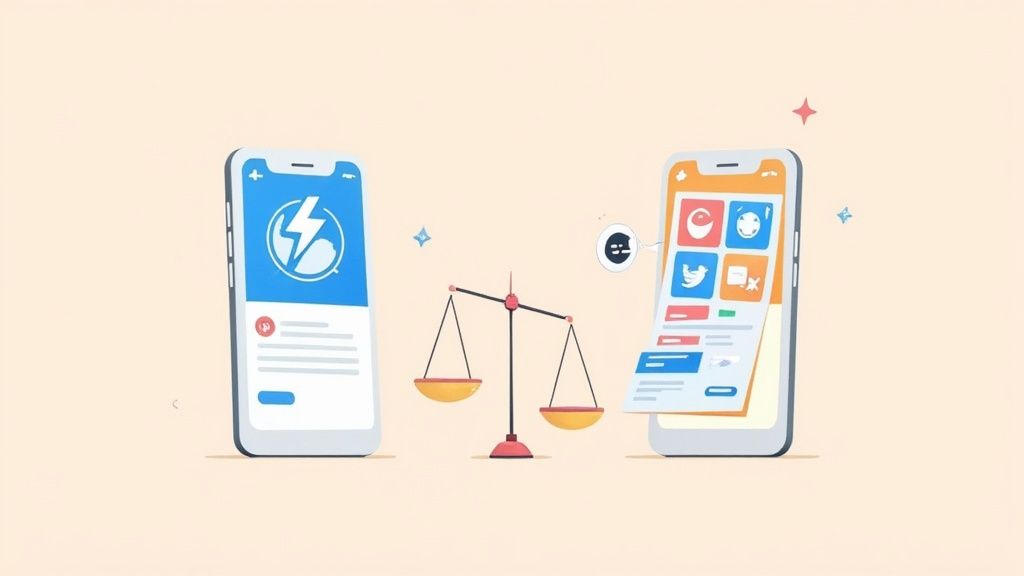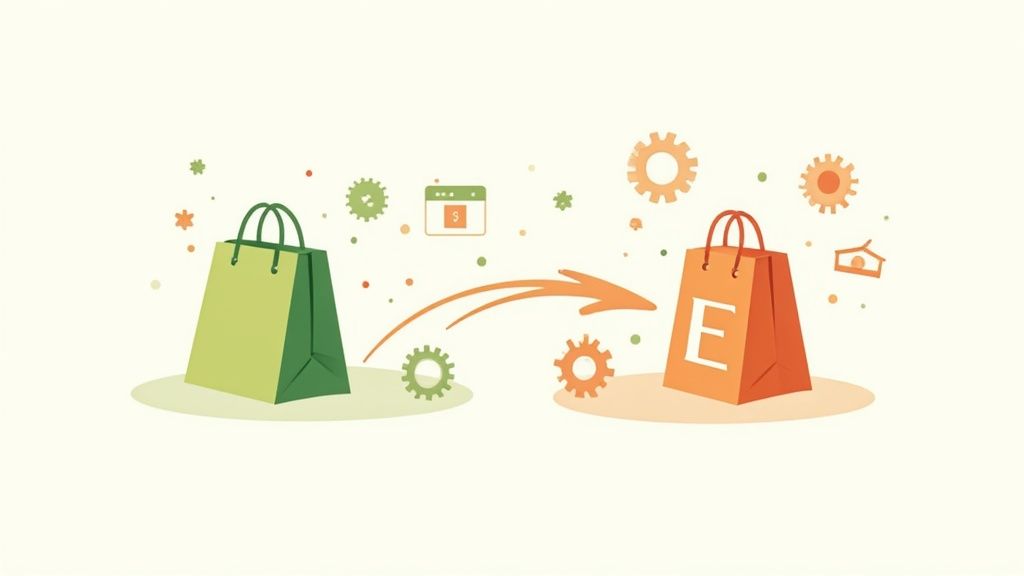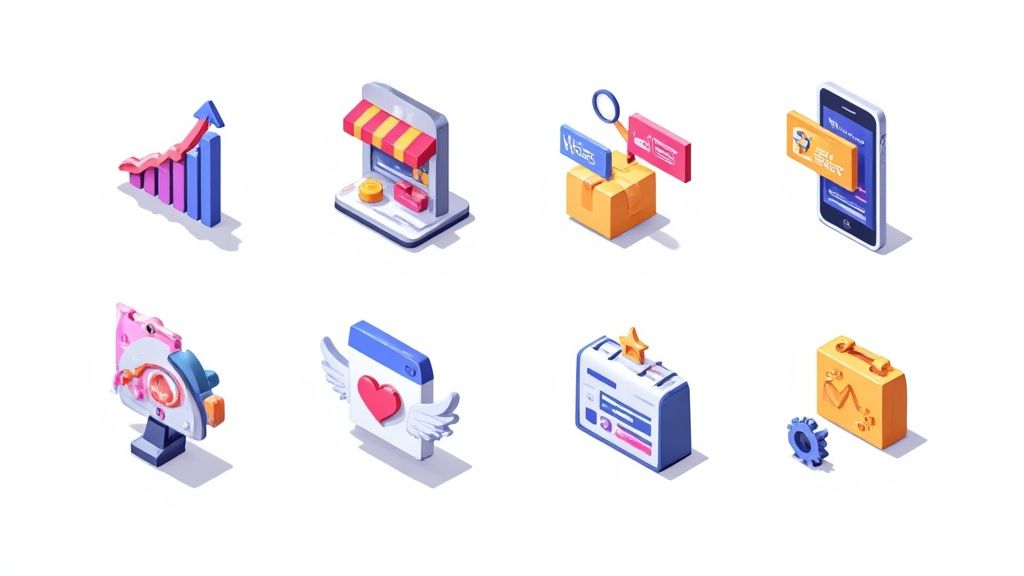
In the hyper-competitive digital marketplace, standing still means falling behind. For ambitious e-commerce brands, sustainable growth isn't a goal; it's a necessity. But with countless channels and tactics, where do you focus your resources for maximum impact? This guide cuts through the noise, providing a blueprint for scalable success. We've compiled nine powerful e-commerce growth strategies, moving beyond the basics to provide actionable frameworks you can implement today.
Forget generic advice. This article delivers specific, tactical playbooks for everything from advanced SEO and data-driven personalization to robust customer retention programs. Each strategy is a proven lever for increasing qualified traffic, converting visitors into customers, and building a loyal community that fuels long-term profitability. We will dissect each method, offering clear implementation steps, real-world examples, and the key metrics you need to track for measurable results.
Whether you're an emerging brand looking to gain traction or an established player aiming for market domination, these insights will form the core of your 2025 growth plan. It's time to stop guessing and start executing with precision. Let's dive into the strategies that will define your brand's trajectory and secure your place at the forefront of the industry.
1. Search Engine Optimization (SEO)
Search Engine Optimization (SEO) is the foundational digital marketing strategy focused on improving your store's visibility in organic search engine results. For an e-commerce business, this means optimizing every part of your site, from product pages to blog posts, so you appear when potential customers search for items you sell. A strong SEO presence builds a sustainable pipeline of high-intent traffic, reducing reliance on paid advertising and establishing your brand as an authority in its niche.
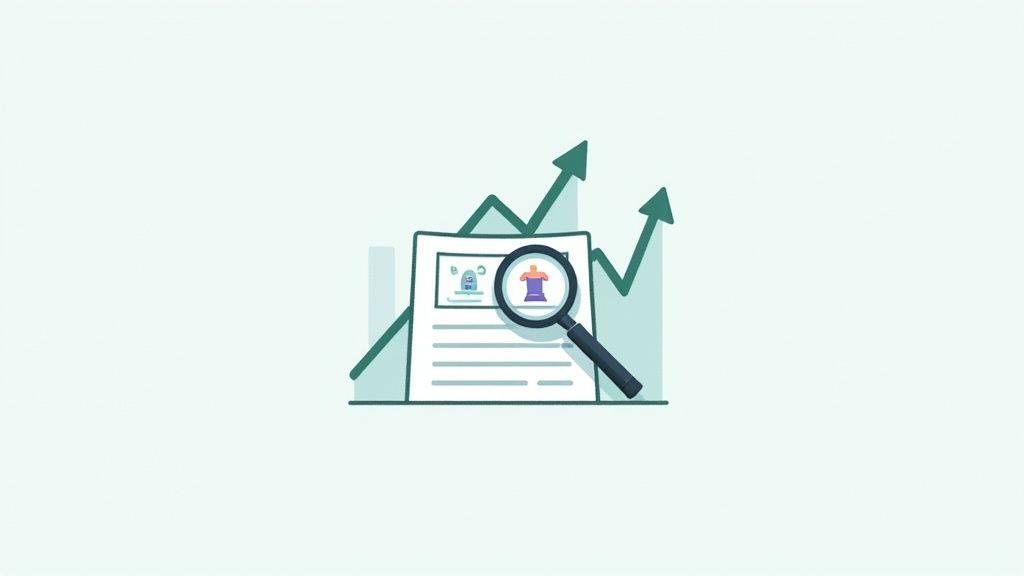
This is one of the most powerful e-commerce growth strategies because it captures customers at the exact moment they are looking to buy. Consider how furniture giant Wayfair dominates broad terms like "area rug" or "patio set" through a massive and meticulously structured site, while outdoor retailer REI uses its expert content blog to attract adventurers who then navigate to product pages.
How to Implement E-commerce SEO
Effective SEO involves a multi-faceted approach that goes beyond simply adding keywords.
- Focus on Commercial Intent Keywords: Target long-tail keywords that signal a user is ready to buy. Instead of "shoes," aim for "women's waterproof trail running shoes size 8." These have lower competition and higher conversion rates.
- Optimize Product Pages: Write unique, detailed product descriptions that answer customer questions. Use high-quality product images with descriptive file names and alt text (e.g.,
brand-product-name-color.jpg). - Implement Schema Markup: Add structured data to your pages to enable rich snippets in search results. This can display prices, ratings, and stock availability directly on Google, increasing click-through rates.
- Build Topic Clusters: Create cornerstone content (e.g., "The Ultimate Guide to Choosing a Coffee Maker") and surround it with related blog posts that link back to the main guide and relevant product categories. This positions you as an expert and boosts rankings for a whole group of keywords.
2. Social Media Marketing
Social Media Marketing is a vital growth strategy that leverages platforms like Instagram, TikTok, Facebook, and Pinterest to build brand awareness, engage with customers, and drive sales. For an e-commerce brand, this means moving beyond simple product posts to create a vibrant community, tell your brand story, and use platform-native tools to make shopping seamless. It transforms passive scrolling into active engagement and purchasing, connecting you directly with where your customers spend their time.

This is one of the most effective e-commerce growth strategies for building a loyal following and driving repeat purchases. Consider how beauty brand Glossier built its empire on Instagram user-generated content, turning customers into advocates. Similarly, Gymshark cultivated a massive community by partnering with fitness influencers, creating an aspirational lifestyle around its products. These brands prove that social media is not just a sales channel but a community-building engine.
How to Implement Social Media Marketing
A successful social strategy requires more than just regular posting; it demands authentic interaction and platform-specific tactics.
- Develop a Content Calendar: Plan your content in advance to maintain consistency and align with marketing campaigns, product launches, and holidays. Mix promotional posts with behind-the-scenes content, user-generated features, and educational material.
- Leverage Platform-Specific Features: Master the tools each platform offers. Use Instagram Stories for daily engagement, TikTok for viral video content, and Pinterest for visual product discovery. Enable shopping tags and in-app checkout where available to reduce friction.
- Engage Authentically with Your Community: Respond to comments and direct messages promptly and personally. Run polls, ask questions, and encourage user-generated content with branded hashtags. This two-way communication builds trust and loyalty.
- Partner with Micro-Influencers: Collaborate with influencers who have a smaller but highly engaged following in your niche. Their endorsements often feel more genuine and can deliver a higher return on investment than a single mega-influencer campaign.
3. Email Marketing Automation
Email Marketing Automation is a systematic approach to nurturing customer relationships through automated email sequences triggered by specific user actions or time intervals. Instead of manual, one-off campaigns, this strategy uses technology to send the right message to the right person at the right time. For e-commerce stores, this means setting up critical touchpoints like welcome series, abandoned cart reminders, and post-purchase follow-ups that run on autopilot, driving sales and fostering loyalty.
This is one of the most effective e-commerce growth strategies because it leverages your existing audience, which is far more cost-effective than acquiring new customers. Consider how Sephora uses its Beauty Insider program emails to send personalized product recommendations and exclusive offers, generating significant repeat purchases. Similarly, Airbnb’s automated emails with timely travel suggestions and booking reminders help convert browsers into buyers and encourage future trips.
How to Implement Email Marketing Automation
A successful automation strategy goes beyond just setting up workflows; it requires deep personalization and strategic segmentation.
- Segment Your Audience: Group subscribers based on purchase history, browsing behavior, or demographic data. Create tailored campaigns for first-time buyers, VIP customers, or users who viewed specific product categories.
- Create Compelling Subject Lines: Use a mix of curiosity, urgency, and personalization to boost open rates. Test different approaches to see what resonates with your specific audience segments.
- Design Clear Calls-to-Action (CTAs): Every automated email should have a clear goal. Use bold, visually distinct buttons with action-oriented text like "Shop Now," "Complete Your Order," or "Discover More."
- Leverage Dynamic Content: Personalize emails by dynamically inserting the recipient's name, recently viewed products, or items related to their past purchases. This makes each communication feel unique and highly relevant. You can explore more advanced techniques by learning about email marketing in ecommerce on ecorn.agency.
4. Customer Retention and Loyalty Programs
While acquiring new customers is essential, one of the most profitable e-commerce growth strategies is focusing on the customers you already have. Customer retention and loyalty programs are strategic initiatives designed to increase customer lifetime value (CLV) by encouraging repeat purchases and building long-term brand relationships. These programs transform one-time buyers into loyal advocates, creating a stable and predictable revenue stream.
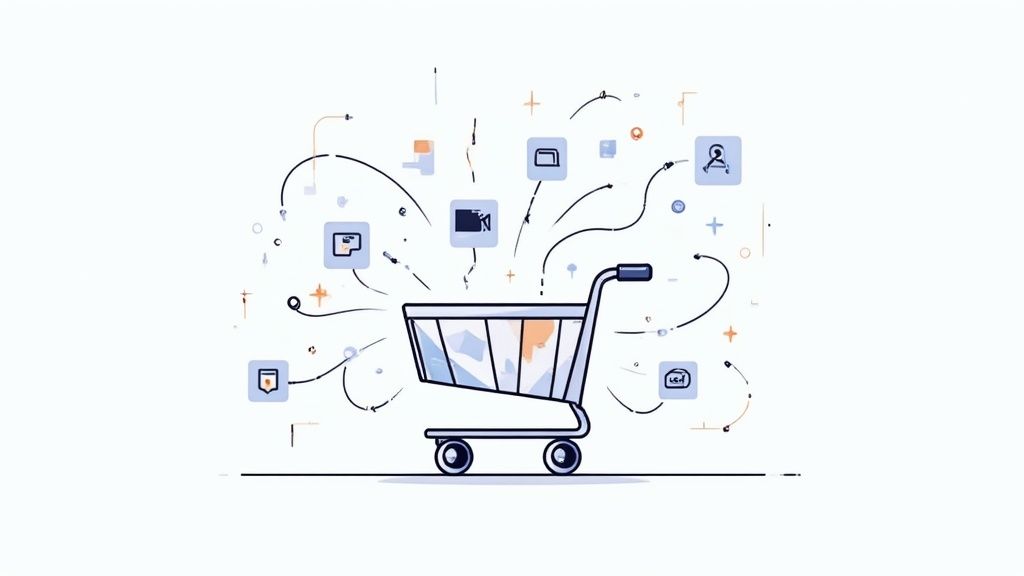
This strategy is powerful because retaining a customer is significantly more cost-effective than acquiring a new one. Consider how Sephora's Beauty Insider program creates a powerful sense of community and exclusivity, driving members to spend more to unlock higher tiers. Similarly, the phenomenal success of Amazon Prime demonstrates how a well-executed loyalty program, with its bundle of compelling benefits, can become the core of a business model, ensuring consistent engagement and sales.
How to Implement a Loyalty Program
A successful loyalty program must feel valuable and be easy for customers to understand and use.
- Make Earning and Redeeming Simple: Design a clear system, whether it's points-based (e.g., 1 point per dollar spent) or tiered. Ensure the path to redemption is straightforward and the rewards are clearly communicated, avoiding complex rules that create friction.
- Offer Experiential Rewards, Not Just Discounts: While discounts are effective, unique rewards like early access to new products, exclusive content, or invitations to special events can build a much stronger emotional connection with your brand.
- Use Gamification to Boost Engagement: Incorporate elements like badges, progress bars, and surprise rewards to make participation fun and addictive. This encourages customers to actively engage with your program rather than passively accumulating points.
- Integrate Loyalty Data with Personalization: Use the data from your loyalty program to deliver highly personalized marketing communications. For instance, you can send targeted offers based on a customer's reward status or past redemptions. To dive deeper into this topic, you can learn more about e-commerce customer retention.
5. Conversion Rate Optimization (CRO)
Conversion Rate Optimization (CRO) is the systematic process of increasing the percentage of website visitors who take a desired action, such as completing a purchase. Instead of focusing on attracting more traffic, CRO is about maximizing the value of the traffic you already have. For an e-commerce brand, this means refining every step of the customer journey, from the homepage to the checkout, to remove friction and encourage conversions.
This is one of the most direct e-commerce growth strategies because even small improvements can lead to significant revenue gains without increasing ad spend. Consider how Booking.com relentlessly tests elements like urgency ("Only 1 room left!") and social proof ("Booked 27 times in the last 24 hours") to drive immediate decisions. Similarly, Shopify empowers merchants with built-in analytics and A/B testing apps to help them continuously refine their store layouts and user flows.
How to Implement E-commerce CRO
Effective CRO is a data-driven science that involves hypothesizing, testing, and iterating.
- Simplify the Checkout Process: Eliminate unnecessary form fields, offer guest checkout, and provide multiple payment options. Each extra step or moment of confusion is an opportunity for a potential customer to abandon their cart.
- Use High-Quality Visuals and Copy: Showcase products with professional photos, videos, and 360-degree views. Your product copy should not just describe features but sell benefits, answering key questions and overcoming objections.
- Leverage Urgency and Scarcity Ethically: Use tactics like limited-time offers, low stock indicators, and countdown timers to encourage immediate action. Be transparent and avoid creating false pressure, which can damage trust.
- Prioritize Mobile Optimization: With a majority of e-commerce traffic coming from mobile devices, a clunky mobile experience is a major conversion killer. Ensure buttons are easily tappable, navigation is simple, and page load speeds are fast on smaller screens.
6. Marketplace Expansion
Marketplace Expansion is the strategy of selling your products on established third-party platforms like Amazon, eBay, or Walmart. Instead of relying solely on your own website's traffic, this approach taps into the massive, high-intent customer bases these giants have already built. It's a powerful way to accelerate brand discovery, test new markets, and diversify your revenue streams with relatively low initial investment.
This is one of the most scalable e-commerce growth strategies because it leverages existing infrastructure for fulfillment, payments, and customer trust. Consider how electronics brand Anker grew into a global leader by first dominating listings on Amazon, using the platform’s built-in tools to achieve massive reach. Similarly, specialized agencies like Pattern help established brands like Stance navigate and conquer multiple global marketplaces simultaneously, demonstrating its effectiveness at any scale.
How to Implement Marketplace Expansion
Successfully launching on a marketplace requires more than just uploading your product catalog. Each platform has its own algorithm and customer expectations.
- Optimize Listings for Platform Search: Each marketplace has a unique search engine. Research and use platform-specific keywords in your titles, descriptions, and backend search terms. For example, Amazon’s A9 algorithm prioritizes different factors than Google’s.
- Maintain Competitive Pricing: Use repricing tools to monitor competitors and adjust your prices automatically. However, ensure you protect your profit margins and avoid a race to the bottom that devalues your brand.
- Focus on Gaining Early Reviews: Social proof is critical. Use programs like Amazon Vine or post-purchase email campaigns to encourage early, positive reviews, which significantly boost visibility and conversion rates. Expanding your sales channels to major online platforms is a crucial e-commerce growth strategy. Discover comprehensive guides on how to optimize your presence by learning about selling on eBay.
- Utilize Marketplace Advertising: Leverage platform-specific advertising tools like Amazon Sponsored Products or eBay Promoted Listings. These campaigns can dramatically increase visibility and drive sales directly at the point of purchase.
7. Influencer and Affiliate Marketing
Influencer and affiliate marketing are powerful, performance-based strategies where businesses partner with content creators and brand advocates to promote products. This approach leverages the pre-built trust and engaged audiences of partners to drive awareness, traffic, and sales, often on a commission or fee basis. It allows brands to tap into niche communities with authentic endorsements that feel less like traditional advertising.
This is one of the most effective e-commerce growth strategies because it utilizes word-of-mouth at scale. Consider how watch brand Daniel Wellington famously built its empire by gifting products to thousands of micro-influencers on Instagram, creating a wave of user-generated content. Similarly, the newsletter Morning Brew grew to millions of subscribers largely through a robust referral program that incentivized its most loyal readers to become powerful affiliates.
How to Implement Influencer and Affiliate Marketing
A successful program requires more than just sending free products; it demands careful planning and relationship management. A key aspect of successful implementation is developing a robust influencer marketing strategy to ensure your efforts are targeted and measurable.
- Start with Micro-Influencers: Partner with creators in your specific niche who have smaller but highly engaged followings. Their recommendations often carry more weight and deliver a higher return on investment than those from mega-celebrities.
- Provide High-Quality Creative Assets: Equip your partners with a suite of professional images, banners, copy templates, and product information. This makes it easier for them to promote your brand effectively and maintain brand consistency.
- Create Exclusive Discount Codes: Offer unique, trackable discount codes for each partner. This not only provides a clear incentive for their audience to purchase but also simplifies commission tracking and performance analysis.
- Build Long-Term Relationships: Focus on creating genuine, lasting partnerships rather than one-off transactional campaigns. Nurturing these relationships turns influencers and affiliates into true brand ambassadors who provide ongoing value.
8. Mobile Commerce Optimization
Mobile Commerce Optimization, or m-commerce, is the process of creating seamless shopping experiences specifically designed for users on smartphones and tablets. With mobile traffic often exceeding desktop, this strategy involves more than just a responsive website; it means building a mobile-first user journey, from discovery to checkout, that is fast, intuitive, and secure. A superior mobile experience is a non-negotiable e-commerce growth strategy, as it directly addresses where a majority of customers are now shopping.
This approach is critical for capturing sales from an increasingly on-the-go audience. Consider how fashion retailer ASOS generates a reported 70% of its traffic from mobile devices, investing heavily in its app's functionality. Similarly, Wish built its entire business model around a mobile-first, discovery-based shopping experience, proving that a dedicated mobile strategy can create a global powerhouse.
How to Implement Mobile Commerce Optimization
A successful mobile strategy prioritizes speed, simplicity, and accessibility for the small screen.
- Prioritize Page Loading Speed: Mobile users are impatient. Compress images, leverage browser caching, and minimize code to ensure your pages load in under three seconds. Use Google's PageSpeed Insights to test and identify bottlenecks.
- Implement Thumb-Friendly Navigation: Design your interface with the thumb's natural range of motion in mind. Place key navigation buttons, search bars, and "add to cart" buttons in easily accessible zones at the bottom or center of the screen.
- Offer Diverse Mobile Payment Options: Simplify the checkout process by integrating digital wallets like Apple Pay, Google Pay, and PayPal. These options eliminate the need for manual credit card entry, a major friction point on mobile.
- Extensively Test the Checkout Process: Regularly test your entire checkout flow on a variety of real devices and screen sizes, not just emulators. A single bug or layout issue on a popular device like an iPhone can lead to significant cart abandonment.
9. Data-Driven Personalization
Data-driven personalization is the strategy of using customer data and analytics to tailor the shopping experience to each individual. This goes beyond just using a customer's first name in an email. It involves leveraging behavioral data, purchase history, and even real-time actions to deliver personalized product recommendations, dynamic content, and targeted marketing messages, often powered by AI and machine learning.
This is one of the most effective e-commerce growth strategies because it transforms a generic storefront into a personal shopping assistant. Consider how Amazon’s recommendation engine, which is responsible for a significant portion of its revenue, suggests products you are highly likely to buy. Similarly, Spotify uses its algorithm to create custom “Discover Weekly” playlists, a model e-commerce brands can adapt to curate product discovery for their customers.
How to Implement Data-Driven Personalization
True personalization requires a strategic approach to collecting and activating customer data.
- Start with Segmentation: Before implementing complex AI, begin by segmenting your audience based on clear criteria like purchase history, browsing behavior, or location. Create targeted campaigns for these groups, such as showing winter coats to customers in colder climates.
- Use Progressive Profiling: Avoid overwhelming new visitors with long sign-up forms. Instead, gather information gradually. Ask for their birthday in a follow-up email or their product preferences through an on-site quiz in exchange for a discount.
- Implement Dynamic Product Recommendations: Use tools to add "Customers Also Bought" or "Recently Viewed" sections to your product and cart pages. This simple form of personalization increases average order value and aids product discovery.
- Ensure Data Privacy Compliance: Be transparent about the data you collect and how you use it. Adhering to regulations like GDPR and CCPA is not just legally required; it builds trust with your customers.
E-Commerce Growth Strategies Comparison
From Strategy to Success: Your Next Move
The digital marketplace is in a perpetual state of evolution, yet the core tenets of sustainable growth remain constant. The journey through these nine distinct e-commerce growth strategies, from foundational SEO to advanced data-driven personalization, provides a comprehensive roadmap for any brand aiming to scale. We've explored how optimizing your mobile experience, expanding into new marketplaces, and nurturing customer loyalty aren't just isolated tasks; they are interconnected components of a powerful growth engine. Each strategy offers a unique lever to pull, whether your immediate goal is to attract new traffic, maximize conversions, or increase lifetime value.
The true differentiator between a business that stagnates and one that thrives is not merely knowing these strategies but executing them with precision and consistency. The wealth of information can feel overwhelming, but the path forward is simpler than it appears. It begins with a single, focused step. Don't attempt to implement all nine strategies at once. Instead, perform a candid assessment of your business's current state. Where are your biggest bottlenecks? Where lies the most significant untapped opportunity?
Charting Your Course: Actionable Next Steps
To translate this knowledge into tangible results, start by selecting one or two strategies that promise the highest impact for your current stage. This focused approach ensures that your resources are concentrated for maximum effect, preventing the dilution of effort that comes from trying to do everything simultaneously.
Consider these starting points based on your primary objective:
- If you need more qualified traffic: Begin with a deep dive into Search Engine Optimization (SEO) to build a sustainable organic channel, or launch a targeted Influencer and Affiliate Marketing campaign to tap into established audiences.
- If your traffic is good but sales are low: Prioritize Conversion Rate Optimization (CRO). A small improvement in your conversion rate can have a massive impact on your bottom line without needing a single new visitor.
- If you struggle with repeat business: Focus your energy on Email Marketing Automation and designing a compelling Customer Retention and Loyalty Program. It is far more cost-effective to retain an existing customer than to acquire a new one.
Once you have chosen your focus, commit to a cycle of implementation, measurement, and iteration. Define your key metrics, set realistic targets, and continuously analyze the data to refine your approach. Remember, the most successful e-commerce brands are not those that get it perfect on the first try, but those that are masters of adaptation. They test, they learn, and they relentlessly optimize.
These e-commerce growth strategies are your toolkit for building a resilient, profitable, and enduring brand. By moving from passive learning to active implementation, you transform abstract concepts into real-world revenue and brand equity. The path to scaling your e-commerce business is a marathon, not a sprint, but with these proven frameworks, you are well-equipped to set a winning pace.
Ready to accelerate your growth and implement these strategies with expert precision? At ECORN, we specialize in turning ambitious e-commerce brands into market leaders through data-driven CRO, development, and strategic consulting. Partner with us to transform your growth plan into a powerful success story.






